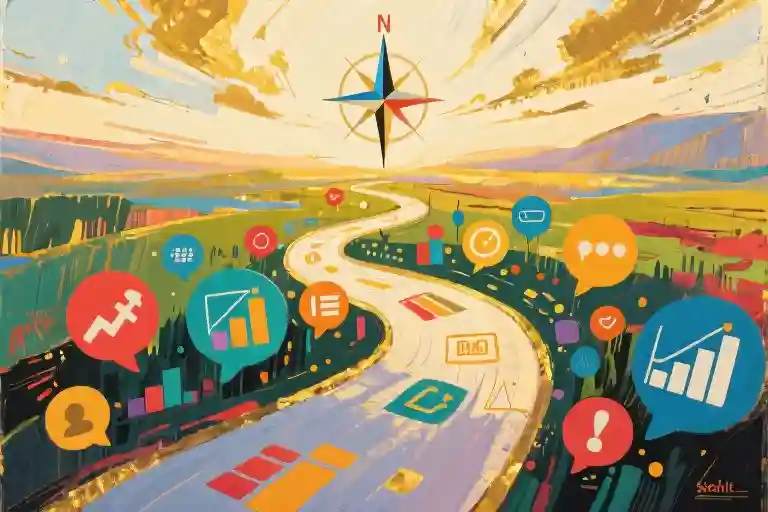A LinkedIn study reveals 75% of professionals make radical career changes by age 40. Where does your path fit in this landscape?
Career trajectories rarely follow textbook blueprints. When we survey adults over 40, their work histories typically cluster into three distinct patterns—the Early Callers, the Explorers, and the Unexpected Travelers. Each path carries its own wisdom and challenges, yet society often glorifies only one narrative.
Consider which resonates most with you:
- The Early Caller: Knew their vocation by adolescence (“I was born to be a doctor”)
- The Explorer: Sampled multiple fields before landing somewhere tolerable
- The Unexpected Traveler: Stumbled into their current role through circumstance
These aren’t just abstract categories—they’re lived experiences. Sarah, a corporate lawyer, never wavered from her 8th-grade career plan. Michael transitioned from finance to marketing before discovering his gift for teaching. Then there’s Elena, who inherited her parents’ restaurant despite childhood dreams of architecture.
What these stories share is this truth: There’s no universal “right way” to build a career. The 25% who stay in one field aren’t inherently more successful than the 60% who pivot. That catalog model turned baker? She now supplies bread to Michelin-starred chefs.
We’ll unpack why society overvalues linear paths later, but first—which of these narratives feels closest to your experience? Hold that thought as we examine each pattern’s hidden strengths.
The Three Scripts of Career Journeys
The Early Callers (15%)
Some people just know. By their mid-teens, they’ve already mapped out their professional lives with startling clarity. Meet Sarah, a veterinarian who’s never considered another path since bandaging her first stuffed animal at age twelve. For these individuals, career decisions feel less like choices and more like inevitabilities.
Key characteristics:
- Laser-focused direction by late adolescence
- Minimal career-related doubt or exploration
- Often exhibit early passion indicators (e.g., childhood hobbies aligning with profession)
The hidden trade-offs:
While this path appears enviably straightforward, our veterinary case study Sarah confesses: “I sometimes wonder what other talents I might have developed if I’d allowed myself to explore.” The very certainty that fuels their success can become a blind spot, potentially limiting exposure to alternative strengths or unexpected joys.
The Explorers (60%)
This isn’t just the largest group—it’s where most compelling career change stories originate. Take Michael, whose professional timeline reads like a travelogue: banking analyst → advertising creative → high school economics teacher. Each pivot wasn’t a failure, but a deliberate step toward better alignment between his skills and values.
Why this path matters:
- Builds diverse skill sets that fuel innovation
- Develops resilience through calculated risks
- Often leads to unexpected synergies (e.g., banking rigor + creative storytelling = engaging teacher)
The explorer’s advantage:
In an era where the average career spans 60+ years, those comfortable with reinvention hold a distinct edge. Michael’s classroom now benefits from his corporate financial literacy and agency brainstorming techniques—precisely the type of cross-pollination modern workplaces reward.
The Opportunity-Takers (25%)
Career trajectories aren’t always about passion or planning. For immigrant families, economic realities often dictate professional paths. Consider the Nguyen family’s restaurant—a business the second generation inherited not by choice, but from a profound sense of duty and limited alternatives.
Redefining success:
- Provides stability for families/communities
- Develops deep expertise through longevity
- Creates unexpected fulfillment (many discover passion in mastery over time)
The cultural dimension:
In collectivist societies particularly, this path represents not resignation, but a different value system. As the Nguyen siblings note: “Our ‘sacrifice’ gave our parents retirement security and our kids college funds—that’s our version of making it.”
Why Your Path Isn’t Wrong
These narratives aren’t just descriptive—they’re liberating. When LinkedIn data shows 75% of professionals make significant mid-career shifts, it confirms that nonlinear career paths aren’t exceptions; they’re the modern standard. The key insight? All three scripts can lead to fulfillment when we:
- Recognize our type without judgment
- Leverage its inherent strengths
- Mitigate its potential blind spots
Your career isn’t a single-choice test with one right answer. It’s an evolving story where you’re both author and protagonist—free to edit as you grow.
How Society Distorts Our Career Perspectives
We’ve been handed a script about how careers should unfold—a linear trajectory where early passion meets lifelong dedication. But when 75% of professionals deviate from this path by age 40 (LinkedIn, 2023), why does this outdated narrative persist? Let’s examine three invisible forces shaping our career anxieties.
The “Declare Your Major” Pressure Cooker
From freshman year orientations to family gatherings, we’re conditioned to treat career choices like binding contracts. Educational systems reward early specialization—consider how:
- College applications favor “focused” extracurriculars over exploratory ones
- Career aptitude tests suggest permanent labels (“You’re an ENTJ—become a CEO!”)
- Internship pipelines lock students into industries by sophomore year
The ripple effect: A 2021 Gallup study found 53% of graduates would change majors if given another chance. Yet we keep asking high schoolers, “What do you want to be?” as if 17-year-olds possess crystal balls.
Media’s “Prodigy Industrial Complex”
For every Mark Zuckerberg founding Facebook at 20, there are 10,000 late bloomers—but you’d never know it from headlines. The media obsession with:
- 30 Under 30 lists (implying expiration dates on achievement)
- “Overnight success” founder stories (erasing years of trial/error)
- Career origin myths (“I always knew I’d be a billionaire”)
creates what psychologists call narrative distortion—the false sense that extraordinary timelines are ordinary. Meanwhile, Julia Child published her first cookbook at 49, and Vera Wang entered fashion at 40.
Our Brain’s Addiction to Straight Lines
Neurologically, humans crave coherent stories. Yale research shows we:
- Remember career paths as 27% more linear than they actually were (hindsight bias)
- Subconsciously associate meandering careers with incompetence (coherence heuristic)
- Feel physical discomfort when hearing non-sequential work histories (cognitive dissonance)
The irony? The same mental shortcuts that helped our ancestors avoid predators now make us judge hybrid careers as “risky.”
Career Crossroads Moment
Next time you feel “behind,” ask:
🔹 Who benefits from me believing there’s only one right path?
🔹 What evidence do I have that my unique timeline is actually working?
This cultural detox won’t happen overnight—but recognizing these hidden scripts is step one toward writing your own rules.
Measuring Your Non-Career Happiness
Career success often dominates our conversations, but what about the quiet joys that happen outside office hours? For many professionals—especially those navigating midlife career changes or nonlinear career paths—true fulfillment lives in those uncharted territories between paychecks and promotions.
Family Time: School Runs vs. Corner Offices
Consider Mark, a former tech executive who stepped down from his VP role after missing his daughter’s first ballet recital. “I realized my LinkedIn title meant nothing to a six-year-old waiting backstage,” he reflects. His career transition into freelance consulting allowed him to become the primary school-run parent—a shift that surprised colleagues but brought unexpected richness to his daily life.
This tension between career advancement and family presence manifests differently across cultures:
- North America: 72% of professionals report declining promotions for family time (Gallup 2022)
- Europe: 58% prioritize flexible schedules over salary increases
- Asia: Rising ‘slow career’ movement among millennials
The real question isn’t “Which matters more?” but “When did we decide these were mutually exclusive?” Hybrid work models and the gig economy are proving that career satisfaction and family engagement can coexist—just rarely in the ways corporate ladder-climbing handbooks suggest.
Health Capital: Your Body‘s Balance Sheet
Sarah\u2019s story illustrates the hidden costs of high-pressure careers. As a Wall Street analyst working 80-hour weeks, she developed chronic migraines and insomnia by age 35. Her ‘successful career transition’ wasn’t to another finance role but to becoming a yoga instructor\u2014a move that cut her income by 60% but restored her health.
Common health trade-offs in demanding careers:
| Career Stage | Typical Health Sacrifices | Long-Term Impact |
|---|---|---|
| Early Career | Sleep deprivation | Reduced immunity |
| Mid-Career | Chronic stress | Cardiovascular risk |
| Late Career | Sedentary habits | Joint/mobility issues |
The pandemic accelerated awareness of these trade-offs, with 41% of professionals now ranking health benefits above salary in job considerations (LinkedIn 2023). This shift reflects growing recognition that no career achievement outweighs the ability to enjoy life outside work.
The Freedom Test: “If Money Were No Object…”
Here\u2019s a revealing exercise from career change coaches: Imagine complete financial freedom. Would you:
- Keep your current job with modified hours?
- Switch to a completely different field?
- Leave paid work altogether?
Answers often surprise even seasoned professionals. A marketing director might discover her real passion is urban gardening. An engineer might crave museum curation. These aren’t impractical fantasies-they‘re clues to designing more satisfying career narratives.
Three signs your career isn‘t aligning with deeper values:
- Sunday night dread persists despite career success
- You envy friends with “less impressive” but more flexible jobs
- Vacation recovery takes longer than the trip itself
For those exploring nonlinear career paths, this mental exercise helps separate societal expectations from authentic desires. As career transition specialist Dr. Emma Lopez notes: “The jobs we’d do for free often point to where we’ll find sustainable fulfillment.”
Practical Steps Toward Balance
- Conduct a time audit: Track how work hours actually feel versus family/health activities
- Redefine ‘productive’: Count gym sessions or bedtime stories as achievements
- Test small changes: Could leaving early Wednesdays for soccer practice reshape your whole outlook?
Remember: Career satisfaction surveys consistently show that beyond a certain income threshold (~$75k in most regions), additional earnings contribute little to overall happiness. The real differentiators? Autonomy, relationships, and vitality—all factors existing largely outside traditional career metrics.
The most successful career transitions often begin by recognizing that we’ve been measuring the wrong things all along.
Writing Your Own Career Rules
For the Goal-Oriented: Schedule Exploration Breaks
If you’ve always known your career path since adolescence, congratulations—you’re part of the rare 15% with unwavering clarity. But even the most passionate veterinarians and lawyers need to occasionally step outside their well-defined lanes.
Try this: Block one week annually as your “Exploration Sabbatical” to:
- Shadow someone in a completely unrelated field (that tech CEO might secretly envy your florist friend)
- Audit a beginner’s class in a subject that terrifies you (yes, even if it’s interpretive dance)
- Journal about what energizes you outside your expertise zone
Why it works: A 2022 Harvard study found that professionals who deliberately expose themselves to foreign concepts demonstrate 23% higher innovation in their primary fields. Your lifelong passion remains the main course—these are just palate-cleansing sorbets.
For the Explorers: Build Your Transferable Skills Vault
You’ve been the marketing-assistant-turned-yoga-instructor-turned-UI-designer? That’s not inconsistency—it’s adaptive intelligence. The key is recognizing the golden threads connecting your seemingly random career dots.
Your action plan:
- Create a “Super Skills Matrix” tracking:
- Technical abilities (e.g., data visualization from banking)
- Soft skills (conflict resolution from bartending)
- Hidden talents (multilingualism from childhood summers abroad)
- Before considering any new pivot, check which existing skills could:
- Transfer directly (teaching experience → corporate training)
- Combine uniquely (photography + logistics → wedding planner)
Pro tip: Explorers often underestimate their “career capital.” That six-month pottery phase? It trained your spatial reasoning—now leverage it in architecture.
For the Circumstance-Directed: Practice Micro-Choices
Maybe you fell into healthcare administration because your uncle owned a clinic, or stayed in retail management for the flexible hours after having kids. Passive career paths aren’t lesser—they just need occasional conscious steering.
Small but mighty moves:
- Every quarter, identify one aspect of your job you could slightly reshape:
- Swap Wednesday inventory tasks with a coworker who handles client calls
- Propose a new filing system that plays to your love of organization
- Use “5% experiments” to test interests without quitting:
- Volunteer to organize the company picnic if event planning intrigues you
- Take on one freelance project in that field you Google at lunch
Remember: As researcher Herminia Ibarra found, we discover what we want by doing, not just contemplating. Your “accidental” career becomes chosen through these tiny acts of agency.
The Universal Rule: Redefine Progression
All three types share one need—breaking free from society’s obsession with upward linear trajectories. Consider these alternative metrics:
- Depth (mastering nuance in your current role)
- Breadth (adding adjacent skills like learning CRM software)
- Life Fit (adjusting work around parenting/health needs)
Final thought: Your career narrative isn’t locked in stone. The goal-oriented might discover a latent passion for woodworking at 50. The perpetual explorer may finally plant roots. The circumstance-driven could become intentional architects of their next chapter. The only wrong choice? Believing you’re stuck with yesterday’s script.
Rewriting Your Career Story
At this point, you’ve seen the three parallel timelines unfold:
gantt
title Career Path Timelines
dateFormat YYYY
axisFormat %Y
section The Early Caller
Law School :a1, 1995, 3y
Associate Attorney :a2, after a1, 5y
Partner :a3, after a2, 15y
section The Explorer
Banking Intern :b1, 2000, 1y
Marketing Coordinator :b2, 2002, 3y
Teaching Certification :b3, 2008, 2y
High School Teacher :b4, after b3, 10y
section The Opportunist
Retail Manager :c1, 1998, 7y
Family Business :c2, 2005, 20yNotice how each path creates its own version of fulfillment. The attorney finds meaning in mastery, the teacher in varied experiences, the family business owner in stability. None is inherently superior—they’re simply different expressions of a life well-lived.
The Million-Dollar Reflection
Here’s what I want you to consider tonight:
“If you could press rewind and choose a different narrative—knowing what you know now—would you?”
This isn’t about regret. It’s about recognizing that:
- Your past choices made sense with the information you had
- Your current path still holds unused potential
- Your next chapter can incorporate elements from all three narratives
Your Personal Career Toolkit
Before you go, grab these resources:
- Career Narrative Assessment (download PDF)
- Takes 8 minutes
- Reveals which narrative currently dominates your thinking
- Identifies hidden opportunities in your story
- Real-Life Case Library (explore stories)
- 47 verified career transitions
- Filter by age/industry/income level
- Includes “before and after” satisfaction ratings
- Weekly Reflection Prompts (free email series)
- Get one thought-provoking question every Monday
- Example: “What childhood interest have you abandoned that might deserve a second look?”
Parting Thought
Your career isn’t a single-choice multiple-choice test. It’s an essay question where you get to write—and rewrite—the answer as you grow. The only wrong approach? Believing the story is already finished when your best chapters may still be unwritten.





